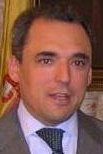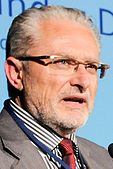October 2003 Madrilenian regional election
| |||||||||||||||||||||||||||||||||||||||||||||||||
All 111 seats in the Assembly of Madrid 56 seats needed for a majority | |||||||||||||||||||||||||||||||||||||||||||||||||
|---|---|---|---|---|---|---|---|---|---|---|---|---|---|---|---|---|---|---|---|---|---|---|---|---|---|---|---|---|---|---|---|---|---|---|---|---|---|---|---|---|---|---|---|---|---|---|---|---|---|
| Opinion polls | |||||||||||||||||||||||||||||||||||||||||||||||||
| Registered | 4,460,349 | ||||||||||||||||||||||||||||||||||||||||||||||||
| Turnout | 2,788,495 (62.5%) | ||||||||||||||||||||||||||||||||||||||||||||||||
| |||||||||||||||||||||||||||||||||||||||||||||||||
| |||||||||||||||||||||||||||||||||||||||||||||||||
The October 2003 Madrilenian regional election was held on Sunday, 26 October 2003, to elect the 7th Assembly of the Community of Madrid. All 111 seats in the Assembly were up for election. This was a snap election, held as a result of the parliamentary deadlock resulting from the May 2003 election and the Tamayazo scandal.
The People's Party (PP) recovered the absolute majority it had lost in the previous election, at the expense of the Spanish Socialist Workers' Party, which suffered from the scandal of its rebel MPs and lost the opportunity to regain the community's government after 8 years in opposition. United Left (IU) made advances, increasing its vote share, but failing to translate it into new seats.
As a result of the election, Esperanza Aguirre was able to be elected as President of Madrid, becoming the first woman to be named to the office.
Electoral system
The 111 members of the Assembly of Madrid were elected using the D'Hondt method and a closed list proportional representation, with a threshold of 5 per 100 of valid votes—which included blank ballots—being applied regionally. Parties not reaching the threshold were not taken into consideration for seat distribution. The Assembly was entitled to one member per each 50,000 inhabitants or fraction greater than 25,000, according to the updated data of the population census.[1][2] Voting was on the basis of universal suffrage, with all nationals over eighteen, registered in the Community of Madrid and in full enjoyment of all political rights entitled to vote.
The electoral law provided that parties, federations, coalitions and groupings of electors were allowed to present lists of candidates. However, groupings of electors were required to secure at least the signature of 0.5 per 100 of the electors entered in electoral register of the Community of Madrid. Electors were barred from signing for more than one list of candidates. Concurrently, parties and federations intending to enter in coalition to take part jointly at an election were required to inform the relevant Electoral Commission within ten days from the election call.[1][3][4]
Elections were fixed for the fourth Sunday of May every four years. The President of the Community of Madrid had the prerogative to dissolve the Assembly and call a snap election, provided that no motion of no confidence was in process, no nationwide election was due and some time requirements were met—namely, that dissolution did not occur either during the first legislative session or within the legislature's last year ahead of its scheduled expiry, nor before one year had elapsed since a previous dissolution—. Additionally, the chamber was to be automatically dissolved and a new election called if an investiture process failed to elect a regional President within a two-month period from the first ballot. Any snap election held as a result of these circumstances would not alter the period to the next ordinary election, with elected deputies merely serving out what remained of their four-year terms.[2][3]
Opinion polls
Vote
Poll results are listed in the table below in reverse chronological order, showing the most recent first. The highest percentage figure in each polling survey is displayed in bold, and the background shaded in the leading party's colour. In the instance that there is a tie, then no figure is shaded. The lead column on the right shows the percentage-point difference between the two parties with the highest figures. Poll results use the date the survey's fieldwork was done, as opposed to the date of publication. However, if such date is unknown, the date of publication will be given instead.
| Date | Polling Firm/Source | PP | PSOE | IU | Oth. | Lead |
|---|---|---|---|---|---|---|
| style="background:Template:People's Party of the Community of Madrid/meta/color;"| | style="background:Template:Socialist Party of Madrid/meta/color;"| | style="background:Template:United Left (Spain)/meta/color;"| | ||||
| 26 Oct 2003 | Regional Election | 48.5 | 39.0 | 8.5 | 4.0 | 9.5 |
| 26 Oct | Sigma-2 | 48.2 | 38.0 | 9.0 | 4.8 | 10.2 |
| 26 Oct | Gallup | 49.0 | 37.9 | 8.7 | 4.4 | 11.1 |
| Exit polls | ||||||
| 12–13 Oct | Opina | 49.5 | 39.0 | 7.1 | 4.4 | 10.5 |
| 4–6 Oct | Opina | 49.5 | 38.0 | 8.0 | 4.5 | 11.5 |
| 27 Sep–5 Oct | CIS | 50.4 | 37.4 | 10.1 | 2.1 | 13.0 |
| 2–3 Sep | TNS-Demoscopia | 48.4 | 39.6 | 9.4 | 2.6 | 8.8 |
| 25 May 2003 | Regional Election | 46.7 | 40.0 | 7.7 | 5.6 | 6.7 |
Seat projections
Opinion polls showing seat projections are displayed in the table below. The highest seat figures in each polling survey have their background shaded in the leading party's colour. In the instance that there is a tie, then no figure is shaded. 56 seats were required for an absolute majority in the Madrid Assembly.
| Date | Polling Firm/Source | PP | PSOE | IU | Others |
|---|---|---|---|---|---|
| style="background:Template:People's Party of the Community of Madrid/meta/color;"| | style="background:Template:Socialist Party of Madrid/meta/color;"| | style="background:Template:United Left (Spain)/meta/color;"| | |||
| 26 Oct 2003 | Regional Election | 57 | 45 | 9 | 0 |
| 26 Oct | Sigma-2 | 56−57 | 44−45 | 9−10 | 0 |
| 26 Oct | Gallup | 57−58 | 43−44 | 9−10 | 0 |
| Exit polls | |||||
| 12–13 Oct | Opina | 57−58 | 45−46 | 8 | 0 |
| 8–9 Oct | PSOE | 54 | 48 | 9 | 0 |
| 4–6 Oct | Opina | 57−58 | 44−45 | 9 | 0 |
| 27 Sep–5 Oct | CIS | 57 | 43 | 11 | 0 |
| 28 Sep | PP | 57 | 45 | 9 | 0 |
| 2–3 Sep | TNS-Demoscopia | 56 | 45 | 10 | 0 |
| 25 May 2003 | Regional Election | 55 | 47 | 9 | 0 |
Results
 | ||||||
| Parties and coalitions | Popular vote | Seats | ||||
|---|---|---|---|---|---|---|
| Votes | % | ±pp | Won | +/− | ||
| width="1" bgcolor="Template:People's Party of the Community of Madrid/meta/color"| | People's Party (PP) | 1,346,588 | 48.48 | +1.81 | 57 | +2 |
| bgcolor="Template:Madrilenian Socialist Federation/meta/color"| | Spanish Socialist Workers' Party (PSOE) | 1,083,205 | 39.00 | –0.99 | 45 | –2 |
| bgcolor="Template:United Left of the Community of Madrid/meta/color"| | United Left of the Community of Madrid (IUCM) | 236,013 | 8.50 | +0.82 | 9 | ±0 |
| Blank ballots | 48,433 | 1.74 | –0.25 | |||
| Total | 2,777,622 | 100.00 | 111 | ±0 | ||
| Valid votes | 2,777,622 | 99.61 | +0.06 | |||
| Invalid votes | 10,873 | 0.39 | –0.06 | |||
| Votes cast / turnout | 2,788,495 | 62.52 | –6.75 | |||
| Abstentions | 1,671,854 | 37.48 | +6.75 | |||
| Registered voters | 4,460,349 | |||||
| Source(s): Assembly of Madrid, historiaelectoral.com | ||||||
Aftermath
Investiture
Investiture processes to elect the President of the Community of Madrid required for an absolute majority—more than half the votes cast—to be obtained in the first ballot. If unsuccessful, a new ballot would be held 48 hours later requiring only of a simple majority—more affirmative than negative votes—to succeed. If such majorities were not achieved, successive candidate proposals would be processed under the same procedure. In the event of the investiture process failing to elect a regional President within a two-month period from the first ballot, the Assembly would be automatically dissolved and a snap election called.[2]
| Investiture of Esperanza Aguirre (PP) |
Yes | No | Abstentions | |||
|---|---|---|---|---|---|---|
| 20 November 2003 (1st ballot) (56/111 required) |
• PP (57) | • PSOE (45) • IUCM (9) |
||||
| Source: historiaelectoral.com | ||||||
References
- ^ a b Community of Madrid Electoral Law of 1986. Official Gazette of the Community of Madrid (Law 11) (in Spanish). November 16, 1986. Retrieved 22 February 2017.
- ^ a b c Statute of Autonomy of the Community of Madrid of 1983. Official State Gazette (Organic Law 3) (in Spanish). February 25, 1983. Retrieved 22 February 2017.
- ^ a b General Electoral System Organic Law of 1985. Official State Gazette (Organic Law 5) (in Spanish). June 19, 1985. Retrieved 28 December 2016.
- ^ "Representation of the people Institutional Act". juntaelectoralcentral.es. Central Electoral Commission. Retrieved 16 June 2017.



